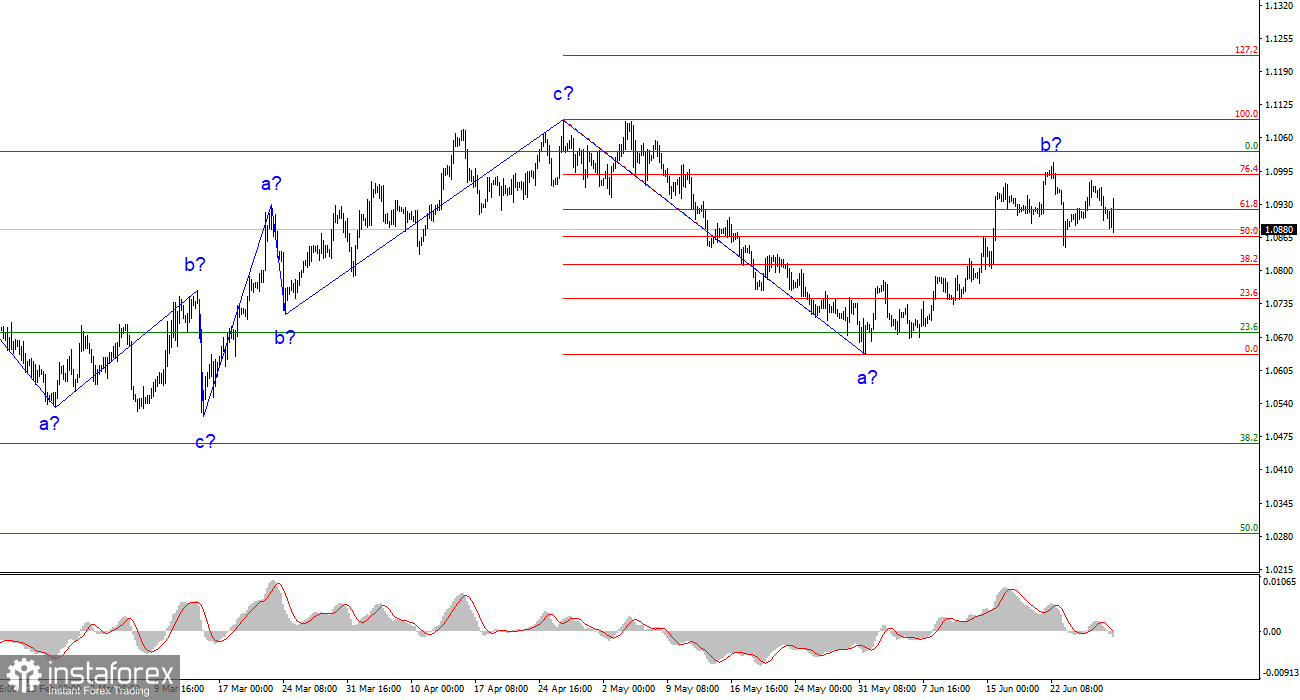
The wave analysis of the 4-hour chart for the euro/dollar pair continues to be non-standard but understandable. Starting from March 15, the ascending trend segment may still theoretically adopt a more complex structure. Still, at the moment, I expect the formation of a downward trend segment, which is likely to be a three-wave structure as well. Recently, I have consistently mentioned that I expect the pair to be near the 1.5 figure, from which the upward three-wave structure started in due time. I am not giving up on my words yet. The presumed wave b may have completed its formation this week, as indicated by the subsequent decline in quotes from the reached peaks.
However, in light of recent events, especially the movements of the GBP/USD pair, I have developed an alternative wave analysis, which suggests that the entire trend segment between March 15 and April 26 is one wave a. If this is indeed the case, then the next wave is b, and we are currently witnessing the formation of an upward wave c. In this case, the wave patterns of the British and European currencies coincide, and everything falls into place. If this assumption is correct, the euro will continue moving towards the 11-figure and higher.
Inflation in the EU raises concerns again
The euro/dollar pair rate decreased by 30 basis points on Thursday. Today's news background was quite extensive, which explains the high amplitude of movements and sharp shifts in market sentiment. Today, Germany released its inflation report for June. The markets were prepared for the consumer price index to accelerate again, but their readiness does not mean there should be no reaction to this report. If inflation starts to accelerate again, even within a month, the ECB will have to raise rates for a longer and stronger period. And this is an excellent supporting factor for the euro.
However, in the second half of the day, the US released its GDP report for the second quarter, which turned out to be significantly stronger than market expectations. The American economy grew by 2% in the first quarter, while forecasts suggested a maximum growth of 1.4% q/q. Therefore, demand increased for the American currency in the second half of the day, and the pair declined, which fully corresponds to the current wave analysis.
Overall conclusions:
Based on the conducted analysis, a downward trend segment continues. The pair still has significant room for decline. I still consider the targets around 1.0500-1.0600 to be quite realistic, and with these targets, I recommend selling the pair based on the signals of the MACD indicator "down." The presumed wave b has been completed. According to the alternative wave analysis, the upward wave will be more extended, but after that, the formation of a downward trend segment should begin. Therefore, I do not recommend buying at the moment in any case.
On a larger wave scale, the wave analysis of the ascending trend segment has taken an extensive form but is likely completed. We have seen five upward waves, most likely the structure of a-b-c-d-e. Then the pair formed two three-wave structures, downward and upward. It is likely in the stage of forming another descending three-wave structure.
 English
English 
 Русский
Русский Bahasa Indonesia
Bahasa Indonesia Bahasa Malay
Bahasa Malay ไทย
ไทย Español
Español Deutsch
Deutsch Български
Български Français
Français Tiếng Việt
Tiếng Việt 中文
中文 বাংলা
বাংলা हिन्दी
हिन्दी Čeština
Čeština Українська
Українська Română
Română


